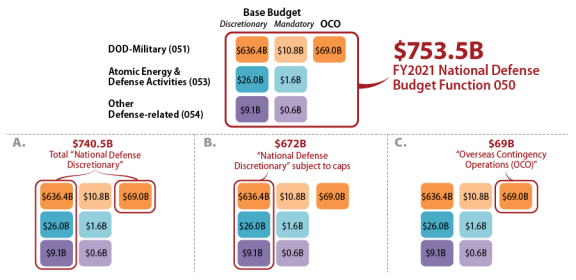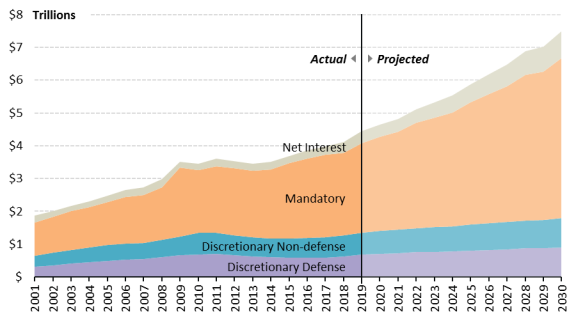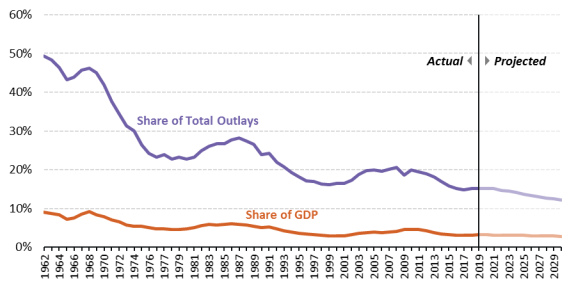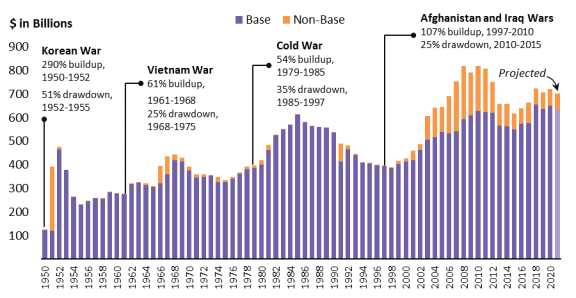Figure 1. FY2021 National Defense (050) Budget Request
(in billions of dollars of budget authority)

Source: OMB, Tables 24-1 and S-7.
Notes: Totals may not sum due to rounding.
The FY2021 President's budget request includes $753.5 billion in budget authority for national defense. National defense is one of 20 major functions used by the Office of Management and Budget (OMB) to aggregate budget data―and the largest in terms of discretionary spending. The national defense budget function (identified by the numerical notation 050) comprises three subfunctions: Department of Defense (DOD)–Military (051); atomic energy defense activities primarily of the Department of Energy (053); and other defense-related activities (054), such as FBI counterintelligence activities.
The $753.5 billion national defense request includes $740.5 billion in discretionary budget authority and $13.0 billion in mandatory budget authority, according to OMB. The request is $3.7 billion (0.5%) less than the FY2020-enacted amount of $757.2 billion. Adjusting for inflation, the FY2021 request is $738.8 billion in constant FY2020 dollars, $18.4 billion (-2.4%) less than the enacted FY2020 amount, according to a CRS analysis of OMB data.
The $740.5 billion requested for national defense discretionary funding includes
See Figure 1.
|
Figure 1. FY2021 National Defense (050) Budget Request (in billions of dollars of budget authority) |
 |
|
Source: OMB, Tables 24-1 and S-7. Notes: Totals may not sum due to rounding. |
Since September 11, 2001, outlays for national defense discretionary programs, in nominal dollars (not adjusted for inflation), increased 130.3% to an estimated $704.8 billion in FY2020, according to data from OMB and the Congressional Budget Office (CBO). Over the same period, outlays for nondefense discretionary programs increased 104.3% to an estimated $700.9 billion in FY2020; meanwhile, outlays for mandatory programs (e.g., Social Security, Medicare, and Medicaid) increased 183.8% to an estimated $2.9 trillion in FY2020. Over the next decade, CBO projects mandatory spending and net interest payments on the national debt will increase faster than defense and nondefense discretionary spending. See Figure 2.
|
Figure 2. Outlays by Budget Enforcement Category, FY2001-FY2030 (Projected) (in trillions of dollars) |
 |
|
Source: OMB, Table 8.1; and CBO, 10-Year Budget Projections, Tables 1-1 and 1-4. Notes: Figures from FY2001 through FY2019 from OMB; projections from FY2020 through FY2030 from CBO. |
Over the past half a century, discretionary defense outlays decreased as a share of total federal outlays (from 49.3% in FY1962 to an estimated 15.2% in FY2020) and Gross Domestic Product (from 9.0% in FY1962 to an estimated 3.2% in FY2020), according to OMB and CBO. See Figure 3.
|
Figure 3. Defense Outlays as a Share of Total Outlays and Gross Domestic Product (GDP), FY1962-FY2030 (Projected) (in percentages) |
 |
|
Source: Figure 1 and OMB Table 10.1. Notes: See Figure 1. |
The request conforms to the FY2021 discretionary defense spending limit (or cap) established by the Bipartisan Budget Act of 2019 (BBA 2019; P.L. 116-37). BBA 2019 raised the discretionary defense spending limit set by the Budget Control Act of 2011 (BCA; P.L. 112-25) to $671.5 billion for FY2021. BBA 2019 specified a nonbinding target of $69 billion in FY2021 for defense funding designated for Overseas Contingency Operations (OCO), which is effectively exempt from the caps. See Table 1.
Table 1. BCA Limits on National Defense (050) Discretionary Base Budget Authority
(in billions of dollars)
|
National Defense (050) |
2012 |
2013 |
2014 |
2015 |
2016 |
2017 |
2018 |
2019 |
2020 |
2021 |
|
Budget Control Act of 2011 |
555 |
546 |
556 |
566 |
577 |
590 |
603 |
616 |
630 |
644 |
|
BCA after automatic revision |
555 |
492 |
501 |
511 |
522 |
535 |
548 |
561 |
575 |
589 |
|
American Taxpayer Relief Act of 2012 |
555 |
518 |
497 |
511 |
522 |
535 |
548 |
561 |
575 |
589 |
|
Bipartisan Budget Act of 2013 |
555 |
518 |
520 |
521 |
523 |
536 |
549 |
562 |
576 |
590 |
|
Bipartisan Budget Act of 2015 |
555 |
518 |
520 |
521 |
548 |
551 |
549 |
562 |
576 |
590 |
|
Bipartisan Budget Act of 2018 |
555 |
518 |
520 |
521 |
548 |
551 |
629 |
647 |
576 |
590 |
|
Bipartisan Budget Act of 2019 |
555 |
518 |
520 |
521 |
548 |
551 |
629 |
647 |
667 |
672 |
Source: CRS Report R44039, The Defense Budget and the Budget Control Act: Frequently Asked Questions.
Notes: This table is an abridged version of one that originally appeared in CRS Report R44874, The Budget Control Act: Frequently Asked Questions.
The $705.4 billion in discretionary funding requested for DOD includes $636.4 billion for the base budget (i.e., the portion of the budget generally used to man, train, and equip the force) and $69 billion in funding designated for OCO. The $69 billion in OCO funding includes
Figure 4 depicts historical DOD funding by base and non-base budget funding.
|
Figure 4. DOD Budget Authority: A Historical Perspective, FY1950-FY2021 (Projected) (in billions of constant FY2020 dollars) |
 |
|
Source: See Figure 1 and CRS Report R44519, Overseas Contingency Operations Funding: Background and Status. |
Table 2 compares FY2020-enacted and FY2021-requested funding by DOD appropriation title.
|
Appropriation Title |
FY2020 (Enacted) |
FY2021 (Request) |
$ Change |
% Change |
||||||||
|
Military Personnel |
|
|
|
|
||||||||
|
Operation and Maintenance |
|
|
|
|
||||||||
|
Procurement |
|
|
|
|
||||||||
|
Research, Development, Test and Evaluation |
|
|
|
|
||||||||
|
Revolving and Management Funds |
|
|
|
|
||||||||
|
Subtotal, Defense Bill |
|
|
|
|
||||||||
|
Military Construction |
|
|
|
|
||||||||
|
Family Housing |
|
|
|
|
||||||||
|
Subtotal, Military Construction-VA Bill |
|
|
|
|
||||||||
|
Total |
|
|
|
|
Source: DOD, FY2021 Defense Budget Overview, p. A-1.
Notes: Totals may not sum due to rounding.